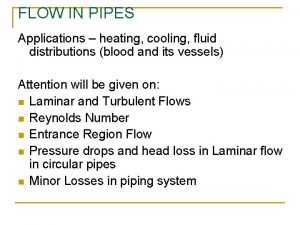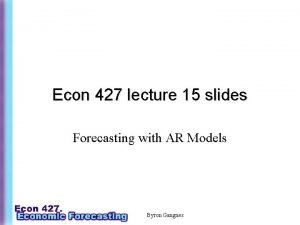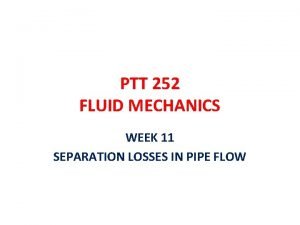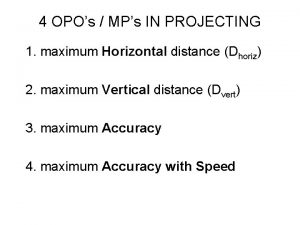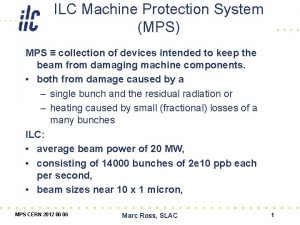4 OPOs MPs IN PROJECTING 1 maximum Horizontal













- Slides: 13

4 OPO’s / MP’s IN PROJECTING 1. maximum Horizontal distance (Dhoriz) 2. maximum Vertical distance (Dvert) 3. maximum Accuracy 4. maximum Accuracy with Speed

Projection Angle ( res ) Vhoriz Vvert Ø res less than 45º Ø long throw Ø long jump Ø Figure 12. 1 page 388 Ø res of 20° = Vhoriz almost 3 times greater than Vvert Ø res greater than 45º Ø volleyball jumps Ø high jump Ø Figure 12. 1 page 388 Ø res of 60° = Vvert more than 2 times greater than Vhoriz

Vector Composition Ø Find Resultant e. g. Resultant Velocity (Vres) Ø Pythagorean Theorem Ø Resultant² which is unknown = the sum of the squares of other 2 components which are known Ø Vres² = Vhorz² + Vvert² Ø Vres² = 4² + 3² Vres = 5 mps @ x°

FORCES Affecting Projectiles I. GRAVITY ü directed toward center of earth @ 9. 8 m/sec² ü decelerates on ascent, accelerates on descent II. DRAG ü results from airflow past projectile ü comprised of: 1. Profile/Form drag 2. Skin Friction/Surface drag

PROFILE/FORM DRAG Primary factor influencing magnitude of drag n magnitude is proportional to the size/area of leading edge of projectile (larger size = more drag) n higher pressure zone on leading side and a lower pressure zone on trailing side of projectile n suction on trailing side n reduced by streamlining n

SKIN FRICTION/SURFACE DRAG Ø Secondary factor influencing magnitude of drag Ø Boundary layer of air “sticks” to projectile Ø rougher surfaces create more friction (“sticking”) Ø reduced using smooth surfaces, tight

Projecting for maximum Vvertical üg is resistive then motive ü Fdrag is always resistive in aerodynamics ü greater V of projectile = greater Fdrag ü on descent, acceleration influenced by Fdrag ü greater projection V = greater height achieved

Vvertical 1. Height of C of G at takeoff point (higher CG @ takeoff = higher apex in flight) 2. Vvert of C of G at takeoff (greater = higher) 3. Location of reaching fingertips @ apex see Figure 12. 4 on page 392

Vertical Projection with some Vhoriz Ø Tumbling - flip-flops increase ground reaction F Ø High Jump - carry body from takeoff to pit Women’s WR 2 m 09 / 1 m 78 tall [diff. 31 cm] Milt Ottey 2 m 32 / 1 m 77 tall [diff. 55 cm] Straddle vs Flop Figures 12. 5, 12. 6 on page 394 Ø Ø Ø Pole Vault - Vhorz critical for pole rotation

Vhorizontal Ø More common in sports Ø Fresistive are g, air resistance, ground friction Features for max. Vhoriz projections are: Ø Critical 1. v of release [faster = farther] most important 2. ht of release [higher = farther] 3. of release [see FIG 12. 8 on page 397]

Factors Affecting DHORZ of Projectiles

“Basic Biomechanics” by Susan J. Hall page 345

Vertical Target Ø darts, archery Ø FIG 12. 15 on page 406 Ø farther target requires more Vvert projection Horizontal Ø basketball, golf, shoes Ø BB rim diameter: = margin of error Ø FIG 12. 16 on page 408 Ø best BB shooters have greater shld flexion + more elbow
 Critical numbers
Critical numbers Maximum likelihood vs maximum parsimony
Maximum likelihood vs maximum parsimony Maximum likelihood vs maximum parsimony
Maximum likelihood vs maximum parsimony Psychology transference
Psychology transference Inward projecting pipe entrance
Inward projecting pipe entrance Twd
Twd Projecting
Projecting Head loss formula for sudden contraction
Head loss formula for sudden contraction Projecting mountain ridge
Projecting mountain ridge Mpš uprava za veterinarstvo
Mpš uprava za veterinarstvo If result is coded as sftvmu then exam
If result is coded as sftvmu then exam How to calculate mps
How to calculate mps Mpc mps 1
Mpc mps 1 This is a living document statement
This is a living document statement




